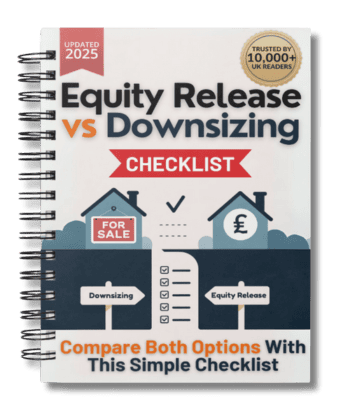
Best Lifetime Mortgage Rates in 2025: Compared & Reviewed
 Be aware. Equity release comes with drawbacks which are important to think about. Lifetime mortgages are secured loans. Compound interest means the amount you owe can grow quickly. Equity release reduces your estate's value and may impact means-tested benefits.
Be aware. Equity release comes with drawbacks which are important to think about. Lifetime mortgages are secured loans. Compound interest means the amount you owe can grow quickly. Equity release reduces your estate's value and may impact means-tested benefits.Key Takeaways...
- UK lifetime mortgage interest rates range from 5.97% to 6.28% - typically higher than standard residential rates due to deferred repayment structures. Rates vary based on age, loan-to-value (LTV), property value, and lender.
- Compound interest significantly affects long-term costs - for example, a £100,000 loan at 6.1% compounds to over £180,000 after 10 years if no repayments are made—highlighting the value of interest-payment options or early repayment allowances1.
- Rates remain below the 2016 peak of 7.2%, but are rising again following base rate increases - advisers are seeing a surge in early applications, with borrowers looking to lock in deals before further hikes2.
In 2025, lifetime mortgage interest rates in the UK range from 5.97% to 6.28%, depending on the provider, product type, and borrower profile. These rates have edged upwards since late 2022, reflecting inflationary pressures and recent increases to the Bank of England’s base rate3.
Despite these rises, current averages remain below the 2016 peak of approximately 7.2%, presenting a comparatively favourable environment for eligible homeowners.
Given the likelihood of further base rate increases, many advisers recommend securing competitive rates now while options remain more accessible.
Whether you're considering equity release for the first time or looking to optimise your existing plan, understanding how lifetime mortgage interest rates work is essential.
This guide distils the latest 2025 market data, lender comparisons, and repayment strategies—giving you the clarity and confidence to make informed decisions about your financial future.
Current rates range from 5.97% to 6.28%. Please note that, while we regularly review our rates, they may have changed since our last update.
What Is a Lifetime Mortgage and How Are Rates Set?
A lifetime mortgage is a regulated equity release product designed for UK homeowners aged 55 or over. It lets you unlock tax-free cash from your home—either as a lump sum or through a drawdown facility—without needing to move or sell.
You retain full ownership, and the loan plus compound interest is typically repaid when you pass away or move into long-term care.
How Do Lenders Set Lifetime Mortgage Rates...
Interest on a lifetime mortgage is typically calculated at a fixed rate agreed upon when your provider makes an offer, and although variable rates are available, they are capped, ensuring some level of predictability.

Rates are determined based on several key factors:
- Your Age – Older applicants are typically offered lower interest rates.
- Loan-to-Value (LTV) – Borrowing a smaller percentage of your home's value can secure a better deal.
- Property Type and Location – Some property types (e.g. ex-local authority flats) may be excluded or attract higher rates.
- Plan Type – Whether the product is lump sum, drawdown, flexible, or interest-payment affects pricing.
- Market Conditions – Lenders factor in the Bank of England base rate, inflation forecasts, and gilt yields.
What Are the Current Lifetime Mortgage Interest Rates in the UK?
Current interest rates for lifetime mortgages in the UK range from 5.97% to 6.28%*, depending on the provider and specific terms.
Typical Lifetime Mortgage Interest Rates (MER) in 2025
| Age | MER (Lump Sum Plan) | MER (Drawdown Plan) |
|---|---|---|
| 55 | 6.29% | 6.29% |
| 60 | 6.29% | 6.29% |
| 65 | 6.29% | 6.29% |
| 70 | 6.29% | 6.29% |
| 75 | 6.29% | 6.29% |
| 85 | 6.31% | 6.31% |
📌 Note: These rates are indicative only and may vary based on lender, LTV band, or applicant details. While we regularly review our rates, they may have changed since our last update.
Are You Wondering Why Do Rates Stay Flat Across Ages?
Most lifetime mortgage lenders use age-banded pricing—for example, one rate for all borrowers between 55 and 75, and a different one for 76+.
The minimal variation in MER across ages reflects this simplified tiered approach. Higher LTV borrowing or lower property values may push rates toward the 6.5–6.8% range².
How Is Interest Calculated on Lifetime Mortgages (AER vs. MER)?
When comparing lifetime mortgage products, it's essential to understand how interest is calculated.
Two key figures come into play: the Monthly Equivalent Rate (MER) and the Annual Equivalent Rate (AER).
MER vs. AER Explained
| Term | Definition | Used For |
|---|---|---|
| MER | The nominal monthly rate at which interest is added to your loan | Quoted by most lenders as the product’s base rate |
| AER | Reflects the total amount of interest charged over a year, including compounding | Shows true cost of borrowing annually |
In simple terms:
MER is what lenders quote.
AER is what you’ll actually pay.
For example, a product with a 6.29% MER will have an AER of around 6.47%, due to monthly compounding—interest being charged on interest.
Why Compound Interest Matters
With most lifetime mortgages, if no interest payments are made, the loan grows exponentially over time. This is because the interest that’s added each month becomes part of the balance that earns interest in the next month.
Example: A £100,000 loan at 6.29% MER will grow to:
- £114,892 after 2 years
- £147,854 after 7 years
- £195,861 after 12 years
(All figures use AER for compounding and assume no voluntary repayments.)
💡PRO TIP: Use an equity release calculator before committing, to compare how different MERs impact your long-term loan balance. You can adjust for age, LTV, and repayment preferences to tailor the results.
How Interest Rates Differ by Lifetime Mortgage Type
Lifetime mortgage interest rates can vary significantly based on the repayment structure and drawdown flexibility of the plan:
| Mortgage Type | Typical Rate (MER) | Key Features |
|---|---|---|
| Lump-Sum | 6.25%–6.35% | Full release upfront; highest interest exposure |
| Drawdown | 6.10%–6.29% | Pay interest only on drawn funds; lower long-term cost |
| Voluntary Payment | 6.15%–6.30% | Allows partial repayments; interest impact reduced |
| Interest-Payment | 5.95%–6.10% | Fixed monthly interest payments; debt balance stays level |
| Capital & Interest (rare) | Custom | Combines repayment with amortisation; low use in UK |
📌 Note: Rates shown are indicative as of 2025 and vary by lender, age, and LTV band.
This structure not only informs but aligns directly with the interest rate comparison theme of the article.

Choosing between these product types isn't just about interest rates—it’s also about how and when interest is applied.
Why Do the Rates Vary?
- Exposure & Risk: Lump sum products expose lenders to full loan value upfront—hence higher rates. Drawdown and interest-payment plans reduce risk through deferred or regular payments.
- Flexibility vs. Cost: Plans offering flexibility (voluntary payments, drawdown) marginally reduce compound interest—but lenders price this in.
- Regulatory Caps & Features: Some providers (e.g., More2life) offer rate reductions on interest-payment plans, helping retain estate value
Mapping your cash flow and repaying accordingly can significantly reduce long-term borrowing costs.
How Do Lifetime Mortgage Rates Compare to Other Equity Release Options?
Lifetime mortgages are the most common type of equity release in the UK, but they aren’t the only option.
Other products, like home reversion plans or hybrid schemes, differ not only in structure but also in how interest—or value—is calculated.
Lifetime Mortgage vs. Other Equity Release Products
| Product Type | Typical Rate/Return (Jun 2025) | How It Works |
|---|---|---|
| Lifetime Mortgage | 5.97%–6.28%¹ (fixed MER) | Interest charged on loan; repaid on death/sale. |
| Interest-Payment Plan | 5.95%–6.10%¹ | Regular interest payments; loan balance remains stable. |
| Drawdown Lifetime Plan | 6.10%–6.29%¹ | Lower long-term cost as interest only applies to released funds. |
| Home Reversion | No interest; you sell part of your home | Lender gets share of home sale value; no interest, but you lose property value. |
| Hybrid Equity Release | Custom | Mixes drawdown with repayment flexibility—rate depends on configuration. |
What are the Key Differences Though?
- Lifetime mortgages accrue interest (compounded monthly), which affects how quickly the loan grows.
- Home reversion has no interest, but you permanently sell part (or all) of your property at below market value.
- Drawdown plans typically lead to lower cumulative interest, as less is borrowed upfront.
- Interest-payment plans are often cheapest long-term—if you can manage regular payments.
Which Is Right for You?
| Need | Best Fit |
|---|---|
| Max cash upfront | Lump-sum lifetime mortgage |
| Long-term cost control | Interest-payment plan |
| Preserve estate value | Home reversion or low-LTV drawdown |
| Flexibility with capital access | Hybrid or drawdown plan |
| No monthly commitments | Lump-sum or standard drawdown |
💡PRO TIP: Always compare real costs—including the AER—and how each option affects your estate or future flexibility.
How Do Market Trends Affect Equity Release Interest Rates?
Lifetime mortgage interest rates are closely tied to broader economic conditions.

Lenders adjust pricing based on the cost of capital, inflation expectations, and overall market risk—just like with residential mortgages, but with longer-term exposure in mind.
Key Market Drivers
| Market Factor | Impact on Lifetime Mortgage Rates |
|---|---|
| Bank of England Base Rate | When base rates rise, lenders' borrowing costs increase, often pushing equity release rates higher. |
| Inflation & Gilt Yields | High inflation or rising gilt yields signal risk—prompting lenders to raise rates for protection. |
| Economic Uncertainty | Periods of volatility (e.g. post-Brexit, pandemic, stagflation) typically result in more expensive, conservative lending terms. |
| Lender Competition | In more stable times, competition may drive down rates, especially for high-LTV or interest-payment plans. |
Example: Market Impact Timeline
| Year | Key Event | Effect on Rates |
|---|---|---|
| 2016 | Post-Brexit vote uncertainty | Rates peaked near 7.2%² |
| 2020 | COVID-19 stimulus & low base rates | Rates fell to 4.5%–5.2% range |
| 2022 | Start of inflationary period | Base rate rises began |
| 2024–25 | Continued inflation & rate hikes | Rates now average 6.1% |
2025 Outlook
As of 2025, the Bank of England base rate remains around 5.25%, with further increases possible if inflation persists. This has already influenced lenders to raise rates across most equity release products, particularly lump-sum and high-LTV plans.
💡PRO TIP: Monitoring the base rate and gilt yields can help anticipate future rate shifts—valuable if you’re considering delaying your application.
How Do Lifetime Mortgage Rates Impact Total Debt Over Time?
Lifetime mortgage rates have a compounding effect—meaning the longer the loan runs without repayment, the more your total debt grows.
Even a small difference in interest rate can have a major impact over 10, 15, or 20 years.
Compound Interest in Action
Let’s look at how different interest rates affect a £50,000 loan over time, assuming no repayments are made:
Loan Growth at 4% Interest (AER)
| Year | Loan Value |
|---|---|
| Year 1 | £52,000 |
| Year 5 | £60,832 |
| Year 10 | £74,012 |
| Year 15 | £90,047 |
| Year 20 | £109,556 |
*This is for indicative purposes only.
Loan Growth at 5% Interest (AER)
| Year | Loan Value |
|---|---|
| Year 1 | £52,500 |
| Year 5 | £63,814 |
| Year 10 | £81,444 |
| Year 15 | £103,946 |
| Year 20 | £132,664 |
*This is for indicative purposes only.
Insight: Just a 1% higher interest rate results in over £23,000 more debt after 20 years on a £50,000 loan.
Why Does This Matter?
Even modest repayments (e.g. £50/month) can significantly reduce final loan size—use a calculator to model this impact over time.
- Higher rates = faster erosion of equity
- Estate value shrinks—especially if no repayments are made
- Options like interest-payment or drawdown can reduce long-term costs
How Can I Estimate the Total Interest on a Lifetime Mortgage?
Estimating the total interest you’ll pay on a lifetime mortgage depends on three main variables:
- Initial loan amount
- Interest rate (MER/AER)
- Loan duration (how long the mortgage runs before repayment)
Because interest is typically compounded monthly, the cost can rise sharply if no repayments are made.
Quick Estimate Example
Let’s say you take a £80,000 lifetime mortgage at a fixed 6.1% AER:
| Loan Duration | Estimated Total Repayable | Total Interest Paid |
|---|---|---|
| 10 years | £145,000 | £65,000 |
| 15 years | £195,000 | £115,000 |
| 20 years | £262,000 | £182,000 |
NOTE: These are estimates assuming no voluntary payments and monthly compounding. To get personalised figures, use a reputable equity release interest calculator.
Input your age, property value, and loan size to see:
- Your total estimated cost
- How much equity might remain in your home
- The impact of voluntary or interest-only payments
💡PRO TIP: Review both MER and AER when comparing quotes. The AER gives a more realistic picture of what you’ll owe over time.

Lifetime Mortgage FAQs
Yes, but early repayment charges (ERCs) may apply. Many plans allow partial repayments (up to 10% per year) without penalty. Some newer plans offer ERC-free windows after a fixed number of years or upon downsizing.
Typical costs include:
-
Valuation fee (£0–£300)
-
Advice fee (often waived by brokers)
-
Legal fees (£500–£1,500)
-
Application fee (some lenders charge ~£600)
Always request a Key Facts Illustration (KFI) for a full breakdown.
Most plans are fixed for life, meaning the rate you agree at the outset won’t change. Some offer variable rates, but these are capped per Equity Release Council standards (usually within a 1–2% band).
They’re typically 2–3% higher. That’s because lifetime mortgages don’t require monthly repayments and are repaid only after death or long-term care—posing greater risk to lenders.
-
Your age
-
Loan-to-value ratio
-
Property type and condition
-
Chosen product type (lump sum, drawdown, etc.)
-
Current base rate and economic conditions
Older borrowers and those requesting lower LTVs usually qualify for lower rates.
No, you retain full ownership. All plans that meet Equity Release Council standards guarantee that you can remain in your home for life or until long-term care is needed.
It could. Funds released via a lifetime mortgage may reduce entitlement to means-tested benefits like Pension Credit or Council Tax Reduction. It’s critical to get independent financial advice.
Final Thoughts on Choosing a Lifetime Mortgage in 2025
With interest rates for lifetime mortgages rising again after historic lows, 2025 presents a pivotal moment for homeowners exploring equity release.
While current rates remain below the 2016 peak, they’re climbing in response to economic pressure and base rate increases.
Choosing the right product—whether it’s a lump sum, drawdown, or interest-payment plan—can significantly affect how much you or your estate will ultimately repay.
Speak to an experienced equity release adviser to discuss the lifetime mortgage interest rates you could qualify for.

Found an Error? Please report it here.





 100% private. No pressure. Just friendly guidance.
100% private. No pressure. Just friendly guidance.



